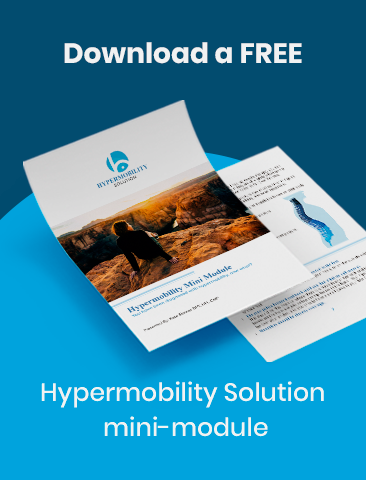This month, we will be debunking Hypermobility Diagnosis.
Hypermobility is linked to many different connective tissue disorders, making diagnosing difficult. Symptoms can vary depending on the individual, making getting an accurate diagnosis complicated to achieve.
Keep reading to understand everything there is to know about Hypermobility Diagnosis.
Should I be discouraged by a referral?
Since not every doctor is familiar with Hypermobility, they may have to learn themselves. If not, they may refer you to somebody who makes most diagnoses through an assessment.
In these types of assessments, they will generally look at your joint movements, height and wingspan ratios, skin, bruising, and abilities. After assessing these qualities, they will analyze your results and determine the correct diagnosis. With this, they will also rule out other disorders or syndromes.
As much as we’d like every test to be definitive and tell us exactly what we need to know, unfortunately, they don’t always work that way.
Is Hypermobility a genetic condition?
Although the underlying genetic cause of hypermobility is unknown, it appears to follow an autosomal dominant inheritance pattern.
This means that a person only needs a change (mutation) in one copy of the responsible gene in each cell to be affected. In some cases, an affected person inherits the mutation from an affected parent. Other cases may result from new (de novo) mutations in the gene.
These cases occur in people with no history of the disorder in their families. A person with hypermobile EDS has a 50% chance with each pregnancy of passing along the mutated gene to his or her child.
Should you consider genetic testing?
Before getting genetic testing, consider:
- Insure does not typically cover genetic testing, and along with that, it tends to be expensive.
- Figuring out which sets and types of testing will benefit you most can be difficult.
The instances where genetic testing is most effective are family planning and research.
Even though you may have a diagnosis determined by genetic testing, treatment programs tend to address your symptoms and the issues that you’re having.
Whether you’re having pain issues, dislocation issues, or movement issues, you’re still going to treat them the same.

The Beighton Scale
The Beighton Scale has been used to indicate joint hypermobility syndrome for many years.
It can quickly and easily assess generalized joint hypermobility using a 9-point scale. It is used solely as a clinical resource and screening tool.
Joints included are the thumb, spine, elbow, knee, and the base of the pinky finger. If needed, a goniometer can also be used to measure a joint’s angle to determine its range of motion.
If you want to take the Beighton Scale, we have one available at https://kateskinnerpt.com/
How can I explain my diagnosis to friends and family?
So you got your diagnosis; now what?
It is time to debunk Hypermobility Diagnosis.
Should you start explaining what you are going through to everyone, or should you keep things simple?
Here are two approaches you can take when sharing your diagnosis with your friends and family.
In the end, it’s about what you feel comfortable doing:
- Approach 1: keep things broad and simple. Often, our Hypermobility can be overwhelming to understand due to its complex nature. Some people are better at understanding these types of complex conditions than others.
- Approach 2: feel free to share what you are going through, but you do not need to feel obligated to tell your entire story unless you choose to do so on your own.
Four tips to help you cope with a difficult diagnosis
- Give yourself time to absorb the news: anger, denial, fear, and anxiety are all normal reactions to bad news. Allow yourself the chance to work through these emotions.
- Create a support system: reach out to friends and neighbors. They will be better positioned to help you and cope with their own reactions to your condition when they know.
- Educate yourself: search reputable sources to learn as much as you can about your illness and your treatment options.
- Take a deep breath and look ahead: maybe you look ahead day-by-day, or maybe you take a longer view. Your life may not be what you once thought it would be, but you can find a balance.
Rules to live by after your Hypermobility Diagnosis
- You have to understand Hypermobility. You can’t change anything if you don’t know what it is or needs.
- You have to learn how to move correctly. This means all the daily things you do: sit, stand, bend and walk.
- You have to learn how to manage your symptoms, including your severe acute symptoms and everyday symptoms.
- You need to develop a regular exercise program.
- You need to learn self-treatment strategies. What do you do when you have pain? When do you get outside help from medical professionals? And who do you go to?
Remember, having a specific name for your problem isn’t essential in terms of a diagnosis. The exercise of debunking Hypermobility Diagnosis is important since there are many misconceptions around the issue.
It is more vital that you get the treatment you need to move better and live better.

About Kate

Kate Skinner is a Doctor in Physical Therapy, co-founder of Great Divide Physical Therapy, and creator of Hypermobility Solution.
Recent Posts

1 thought on “Debunking Hypermobility Diagnosis”
Leave a Comment
You must be logged in to post a comment.




When I was young it was called being double jointed. my elbow would bend in the opposite direction. It was like a party trick I did for the kids at school. Then when my mother told me to show the doctor, his face dropped. He wasn’t impressed. He told me to stop doing that because it would only get worse. Unfortunately this didn’t make the problem go away. It wasn’t much of a problem until I got older. I was always just very flexible. But I was also always fairly weak. I had trouble building fitness and strength and I was accident prone. Now I am in my sixties, I am in pain a lot of the time. My muscles are always tense because I feel like if I relax, my body will collapse. It seems to have effected my internal organs too. I had a hiatus hernia that had to be operated on, because my stomach didn’t stay where it was supposed to be. I also have problems with balance. I am unsteady on my feet and I find it next to impossible to stand on one leg. Doctors don’t seem to understand. They think being hypermobile simply means that I am flexible.